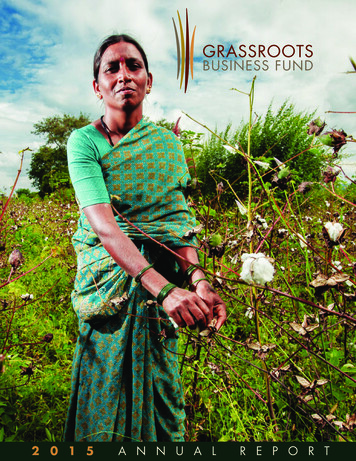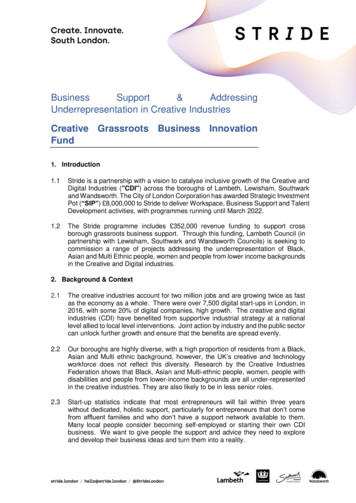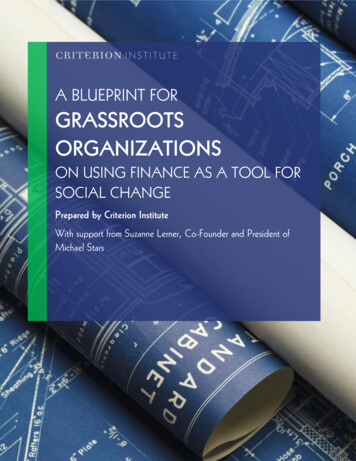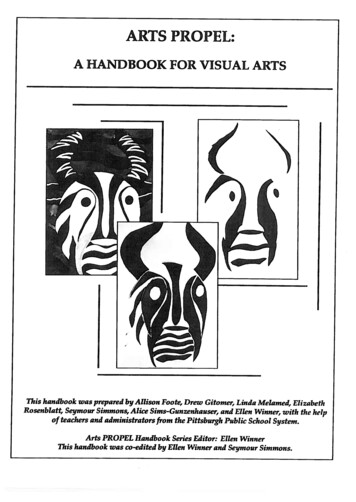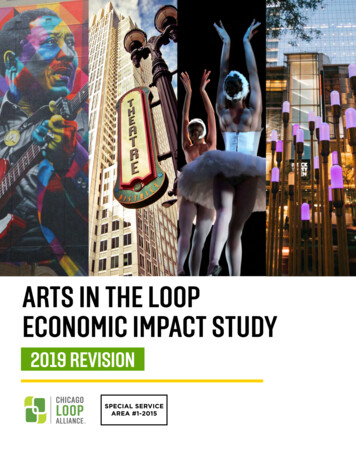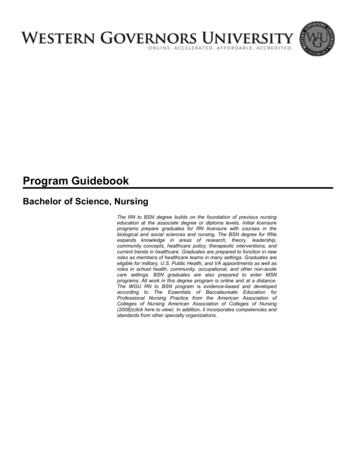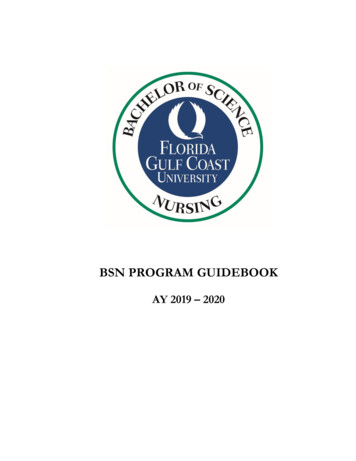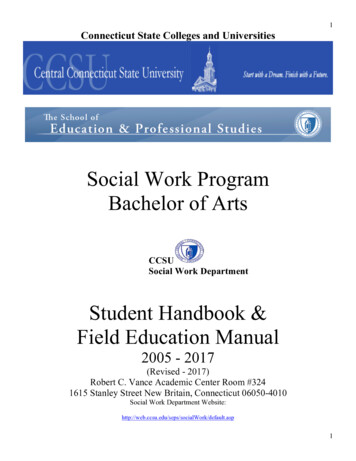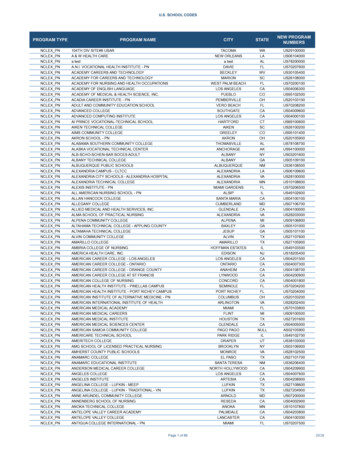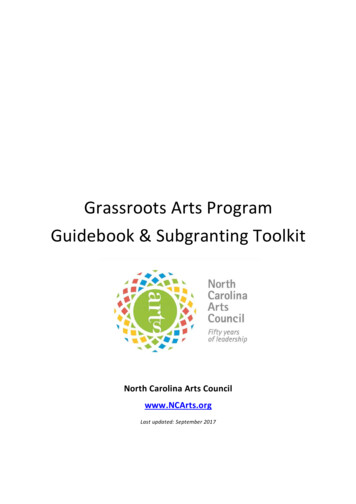
Transcription
Grassroots Arts ProgramGuidebook & Subgranting ToolkitNorth Carolina Arts Councilwww.NCArts.orgLast updated: September 2017
This guidebook was prepared as a resource for the Grassroots Arts Program Partners.The information is also available, and frequently updated, on theNorth Carolina Arts Council’s website alArtsCouncilResources.aspxGrassroots Arts Partners are also encouraged to callNorth Carolina Arts Council staff with questions or to schedule a consultation.Leigh Ann WilderArts in Communities DirectorNorth Carolina Arts Council(919) 807-6508leig h an n .wil d er@ nc dcr .go v2
Table of ContentsI. Grassroots Arts Program: BackgroundPurpose .5Partnership with the North Carolina Arts Council.5How Grassroots Arts Program County Allotments Are Determined.7Matching the Grassroots Grant .7Designated County Partner Standards .8II. Grassroots Arts Program ApplicationAnnual Grant Submission.9How Grants Are Reviewed and Evaluated .13Final Reports .14III. Administering Grassroots FundsApproved Uses of Grassroots Funds .15Racial and Cultural Diversity.16Additional Funding Policies for Grassroots Funds.17North Carolina Arts Council Logo Use and Recognition.20IV. A Step by Step Guide to Subgranting .23V. Subgranting ToolkitHow to Use the Toolkit .29Recommended Timeline for Subgrant Process.30Subgrant Application Form .313
Guidelines for Grassroots Arts Program Subgrants .35Press Release .40Letter to Previous Subgrant Applicants .41Subgrant Review Process .42Responsibilities of Subgrants Panel Members .45Conflict of Interest Policy.46Subgrant Panel Rating Sheet.47Subgrant Award Letter .48Subgrant Contract and Instructions.49Subgrant Instructions .50No Overdue Tax Debt Form .55Subgrant Rejection Letter .56Subgrant Report Form .57Sample Letter to Legislator .604
I. Grassroots Arts Program: BackgroundPurposeIn 1977, the North Carolina General Assembly established the Grassroots Arts Program toensure that every citizen has access to quality arts experiences. The program provides fundingfor the arts in all 100 counties in North Carolina. Funds are primarily distributed through localarts councils using a per capita based formula. The North Carolina Arts Council manages theGrassroots Arts Program for the state and provides technical and program assistance to itscommunity partners.The creation of the Grassroots Arts Program increased the number of local arts councils andhelped establish North Carolina as a leader in community arts development. Nationally, NorthCarolina has one of the largest networks of local arts agencies, including the country’s oldestarts council in Winston-Salem. Grassroots funds support hundreds of arts activities across thestate each year.Partnership with the North Carolina Arts CouncilA local arts council that has been nominated by its county’s board of commissioners andapproved by the North Carolina Arts Council to receive and administer Grassroots funds isknown as a Designated County Partner (DCP). With the assistance and support of the N.C. ArtsCouncil, DCPs have an important role in sustaining and growing the arts in their counties andserving as advocates for the arts in their service areas. DCPs are expected to administer theGrassroots Arts Program in accordance with current standards, policies and requirementsoutlined in this guide.Together, DCPs and the N.C. Arts Council have a shared responsibility to understand thecommunities they serve. DCPs should be familiar with the arts and cultural resources in theircounty—including arts organizations, professional and accomplished artists, and arts andcultural traditions of their region. As advocates for the arts in their communities, DCPs developpartnerships with county governments, schools and universities, city revitalization boards,economic development councils, chambers of commerce and tourism bureaus. Thesepartnerships are often the catalyst for sustainable economic and community developmentutilizing the arts, and can lead to programs that connect diverse parts of a county throughshared arts experiences.5
The North Carolina Arts Council offers a broad range of technical and programming assistanceincluding: Local Arts Council Resources Page: The Local Arts Council Resources page on the N.C.Arts Council website is an online portal for Grassroots Arts Program partners. The siteprovides tools and links including yearly allocation tables, aggregated local governmentsupport data, webinars for completing applications and final reports, as well as thisguidebook. The webpage can be found at: . North Carolina Artist Directory: The North Carolina Artist Directory showcases manyof N.C.’s best choreographers, composers, craft artists, dancers, experimental artists,filmmakers, musicians, theater artists, traditional artists and writers and the ways inwhich they are able to share their art and knowledge with audiences and artsconsumers throughout the state and beyond. The directory features N.C. artistfellowship and heritage award recipients, as well as selected artists who apply and arereviewed by discipline panels. To view, visit http://search.ncarts.org/search-art.php Grassroots Arts in Education Idea Book: This idea book includes a sampling ofarts in education artists in the performing, literary and visual arts, and detaileddescriptions of arts in education residency programs. The Grassroots Arts inEducation Idea Book is a tool for local arts councils to use in partnership with theirschool systems to plan arts in education programs. To view the book, ources North Carolina ArtsMarket: The North Carolina ArtsMarket is a showcase forartists and presenters organized every other year by the North CarolinaPresenters Consortium (www.ncpresenters.org). Executive Directors’ Conference: The N.C. Arts Council hosts a conference forarts council executive directors yearly. The conference offers training andworkshops on specific topics related to arts development and issues, as well asnetworking opportunities with arts managers from across the state. Individual Consultations: The N.C. Arts Council staff consult individually withcommunities to plan and implement arts programs, and provide training, tools andresources for cultural planning, board and staff development, strategic planningand grants writing.6
How Grassroots County Allotments Are DeterminedEach year the North Carolina General Assembly allocates a portion of the state budget forGrassroots funds. Twenty percent of the total Grassroots budget is distributed in equalamounts to all 100 counties, and the remaining 80 percent is distributed using a per capitaformula. A schedule of county allotments using the most recent population estimates isavailable at s.Included in the allotment schedule is a combined percentage of each county’s multiculturalpopulation. A representative portion of each county’s Grassroots allotment must be spent insupport of arts programs that reflect the county’s racial and cultural diversity. For example, ifthe county’s multicultural population is 29 percent of the total population, then at least 29percent of the Grassroots funds should be spent for multicultural programming.Matching the Grassroots GrantThe Grassroots Arts Program legislation requires that county allotments must be matcheddollar for dollar with cash from local sources during the applicable fiscal year. Grassrootsapplicants may match the entire county allotment from within their own budget, or they mayuse the cash match from subgrantees to fulfill the requirement. A Designated County Partnermay also partner with another organization in the county to allow its arts expenditures to bedesignated as a match.If a DCP chooses to fulfill its match with a partnering agreement, the DCP must obtain a letterfrom that partner stating the source, amount, use and fiscal year of the expenditures and givingthe partner’s approval to designate it as a match for the Grassroots allotment. The partnershould be aware that its records become part of the Grassroots contract, and should there bean audit of the Grassroots award, it must be willing to allow its records to be reviewed.Neither Grassroots allocations nor the matching funds may be used to match any other N.C.Arts Council grant. All matching funds must be documented as part of the final report at theend of the fiscal year.7
Designated County Partner StandardsDesignated County Partners (DCPs) must uphold certain standards to maintain their partnershipstatus with the North Carolina Arts Council. These standards are monitored by N.C. Arts Councilstaff and reviewed by grants panel members. The DCP’s commitment to upholding thesestandards is rated in the overall evaluation of its annual grant submission.The standards require DCPs to: Provide support for quality programming in the performing, visual, literary andtraditional arts. Programming choices are responsive to community needs anddemonstrate improvement and innovation. Programming choices also engageconstituents across geographic, cultural, social and economic strata.Foster collaborative relationships with and provide services and support for county artsorganizations and arts resources.Support individual artists in the county through services and opportunities includingappropriately compensating artists for services. Promote and participate in the RegionalArtists Project Grant program.Conduct or support arts in education programs led by qualified artists for pre-K–12students. DCP shows commitment to comprehensive arts education opportunities forcounty’s youth.Demonstrate a commitment to racial and cultural equity in programming, boardrepresentation, governance and administrative practices.Demonstrate stability and fiscal responsibility through effective board and staffleadership, sound administrative practices and strategic planning. If staffed, artscouncils must provide appropriate salaries and benefits.Track economic impact and actively participates in county tourism and economicdevelopment efforts.Maintain a history of managing the Grassroots grant responsibly, and according torequirements, including meeting the deadlines for applications, fulfilling the subgrantingand multicultural requirements and completing final reports.8
II. Grassroots Arts Program ApplicationsAnnual Grant SubmissionDesignated County Partners must submit an annual grant application to be considered forfunding. DCPs are required to submit a full application every three years, and an updateapplication in the off years. To access the DCP application schedule, ourcesApplications are due on the first business day of March by 5 p.m. Online forms are available viathe N.C. Arts Council’s website in mid-January. Applicants must submit their grantselectronically using the GO System.All DCPs are required to provide the following information as part of their grant application:Projected amount of Grassroots funding that will be spent for operating supportand description of how the funds will be used.Operating and expense budgets for the last, current, and upcoming fiscal years.List and description of the multicultural artists and programs.Information on the organization’s personnel and audience.Local government support itemization.Current list of Board of Directors The following information is requested of DCPs required to submit a full application:These questions should be answered as they relate to the entire scope of your organization,not just your role as a DCP. Remember, the grants panelists who review your application maynot be familiar with your organization, so provide specific and compelling information.County Overview1.Briefly describe the county you serve, including population and demographics.Describe notable economic, social, and cultural changes in your county over thepast three years. Describe how your organization contributes to the local and stateeconomy. Include employment, visitor statistics, and other forms of economicimpact you track.9
Programs and Services2. Describe your key programs and activities for the upcoming fiscal year. Indicatewhether these programs occur annually and how they serve the geographicdiversity of your county. Describe how your program choices demonstrateimprovement or innovation. List and describe the artists selected for theseprograms.3. Describe the services you provide to and how you partner with the artsorganizations in your county.4. Describe the services you provide to individual artists in your county and yourparticipation in and support of the Regional Artists Project Grant program.5. Describe the overall process your organization uses to subgrant Grassroots fundsto other groups in your county. Include information on how you publicize theavailability of funds, assistance to applicants, your application review system andthe composition of your subgrant panel.6. Describe the arts in education programs you conduct and fund that benefitchildren and youth in your community.7. Describe how your organization engages the multicultural populations in yourcounty. Include outreach or artistic programs you conduct and fund that areracially and culturally diverse.Organizational Strength8.State the names, titles, and responsibilities of key staff members. Provide salaryranges and benefits for staff positions. Describe the system for evaluating staff.9.Describe your board of directors and its key responsibilities. Describe your boardrotation policy and how new members are recruited and trained.10.Briefly describe the facilities in which your organization conducts its primaryoperations. Indicate whether you own, lease or occupy donated space.11. Describe your organization’s fundraising strategies. Include information onannual fundraising events, and specify the percentage of annual revenue theseactivities contribute to your operating budget.10
12.Describe your organization’s marketing strategies. Include information on howyou use your website and social media in promotion. Provide statistics onwebsite usage, Facebook, and any online projects or campaigns you haveinitiated. Explain how you evaluate the success of your online efforts.13.Describe your organization’s financial condition. Include information about anydebt, deficits, endowment, and surpluses or cash reserves. Describe how yourorganization exercises effective fiscal control and accountability.14.Describe how your organization advocates for public funding for the arts.15.Describe your organization’s planning process. Briefly summarize key goals andobjectives of your current long-range plan.Support MaterialsApplicants have the option to submit support materials to strengthen their grant proposal.The only support material required of DCP applicants is a board of directors list. Supportmaterials may be uploaded to provide context to new initiatives or provide key evidence thatbuilds a case for a strong application. Here are a few examples of support materials to consider: Current strategic planBios and resumes of key staff and partners for a new projectSample brochures or marketing materials of new initiativesReviews or credentials of artistsWork SamplesWork samples are a REQUIREMENT of the Grassroots application. Work Samples convey theartistic quality of two or three artists that will be part of your programs planned for this grantperiod. For visual artists, submit 3 to 5 images using the tools in GO-SMART. These images maybe of a visual artist that will be featured in your gallery, an upcoming artist in residencyprogram, or another visual arts program. Do NOT send pictures of past events, festivals,fundraisers or your facility. For audio samples, submit up to 5 digital files. For video samples ofperforming artists, you may submit a short video clip in GO-SMART or you may supply us withthe link, for example, YouTube, to a performance using the Web Link Collection form.11
The following information is requested of DCPs required to submit an update application:1. Describe any significant changes in your organization (i.e. changes in staff, facilitiesfinancial condition, and organizational structure) that have occurred since your lastapplication.2.Provide a brief description of the programs you will conduct with your 2018-2019grassroots funds.3.Provide your organizational finances. Does your organization have an accumulateddeficit totaling 5 percent or more of your last year’s operating budget, or are youshowing a shortfall for the last, current, or upcoming year?4.What is the accumulated deficit?5.Briefly describe how the organization is addressing the accumulated deficit orcurrent or projected shortfalls.6.Provide an Audience Overview7.Provide Board Demographics and current list of Board of Directors12
How Grassroots Grants Applications Are Reviewed and EvaluatedNorth Carolina Arts Council staff performs a preliminary review of each Grassroots grant applicationto check for completeness and compliance. Arts Council staff troubleshoots potential problemsdirectly with DCPs to ensure that each application is complete prior to the grants panel meeting.Applications are then formally reviewed and evaluated by a geographically and racially divers
Grassroots Arts Program for the state and provides technical and program assistance to its community partners. The creation of the Grassroots Arts Program increased the number of local arts councils and helped establish North Carolina as
